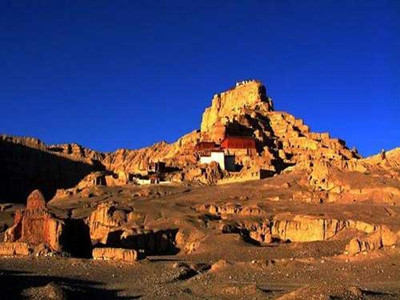In its day, Guge was the Florence of the East.
在興盛時期,古格王朝是東方的佛羅倫斯。
At the time when Genghis Khan's Mongols were advancing into central Asia and Europe, and the Crusades were being fought in Palestine, Guge was a flourishing centre of commerce, art, religion and political power.
當成吉思汗的蒙古大軍挺進中亞及歐洲,當十字軍在巴勒斯坦奮戰時,古格王朝卻是雄霸一方的商業,藝術,宗教及政治中心。
It dominated the strategic crossroads on the Silk Road between central Asia and China, a crossroads for the numerous caravans trading gold, silk, wool and spices.
古格王朝在中亞與中國間的絲路位居樞紐是黃金,絲綢,羊毛及香料。
Guge was the centre of sophisticated art and ideas. a magnet for artisans and intellectuals.
貿易商隊的必經之地古格王朝是藝術中心吸引藝匠及知識份子。
It was at the heart of a religious Renaissance and home to some of the greatest Buddhist thinkers of its time.
古格王朝是宗教復興重鎮,是當時若干最偉大佛教思想家的孕育地。
Yet having prospered for seven centuries, this magnificent kingdom disappeared in 1630, leaving only an enigmatic structure, the very last remaining clue to a lost civilization.
然而在興盛了七個世紀后,古格王朝卻在1630年消失,只留下一座難解的古城供人憑吊消失的古文明。
These are the first ever photographs of the Guge kingdom.
這些是古格王朝首次被拍攝的照片。
They were captured in 1933 by an Italian explorer Giuseppe Tucci.
時間為1933年,拍攝者為義大利探險家吉爾瑟皮·圖奇。
Tucci was the first westerner to document these magnificent ruins.
圖奇是第一位記載古格王朝遺址的西方人。
Tucci was awestruck by what lay before him, he wrote, "In front of us, the whole hillside is covered with tremendous ruins.
圖奇對古格王朝遺址嘖嘖稱奇,他寫道:在我們前方整個土山是一座巨大的遺址。
A dead city, which seems to be keeping visual over a tormented waste of stone."
一座建立在荒蕪土山上的無人古城。
Tucci's visit to the ruins of Guge unearthed no clues to its demise.
圖奇的古格遺址走訪并未挖掘到古格王朝消失的秘密。
譯文屬可可原創,僅供學習交流使用,未經許可請勿轉載











